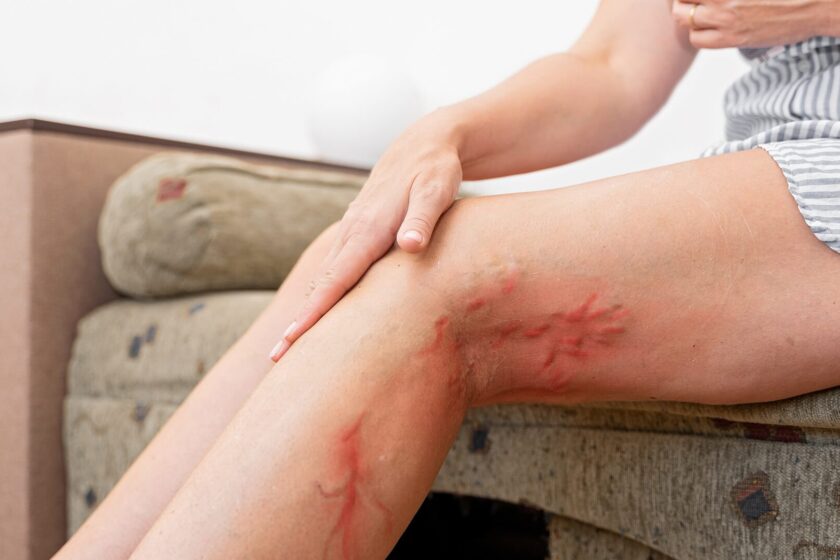
Varicose veins, due to their weakened vein walls and the congestion of blood, can pose serious complications, particularly when they bleed. Understanding this condition, its implications, and the necessary interventions can be lifesaving. Varicose veins can be more than just a cosmetic concern. They might present various complications, one of which is bleeding. This article sheds light on bleeding varicose veins and what immediate actions to take should they rupture.
Introduction to Bleeding Varicose Veins
Varicose veins are more than cosmetic problems. They are swollen, twisted veins that, when damaged or spontaneously rupture, can result in severe bleeding. The walls of these veins are fragile, making them susceptible to ruptures. Knowing how to identify the bleeding from a varicose vein and implementing the correct first-aid measures is essential. The occurrence of bleeding varicose veins is often alarming, and knowing the right steps to handle such a situation can be lifesaving.
Causes and Risk Factors of Bleeding Varicose Veins
Varicose veins occur when valves within the veins don’t function properly, leading to blood pooling in the veins. Over time, this causes them to enlarge and twist. As they swell, the walls of these veins become thin and more prone to rupture, leading to varicose veins rupture.
Factors increasing the risk of bleeding veins in the legs include
- Ageing: The risk of varicose veins increases with age.
- Genetics: A family history can elevate the risk.
- Obesity: Excess weight exerts added pressure on veins.
- Prolonged standing or sitting: This stagnates blood flow, leading to vein enlargement.
Also Read: Top 8 Myths & Facts About Varicose Veins
Complications of Bleeding Varicose Veins
Ruptured varicose veins might look different from typical cuts. Venous blood, being deoxygenated, appears dark red. Moreover, due to the venous system’s lower pressure, the blood tends to pour out rather than squirt. Occasionally, if there is a connection with an incompetent perforator vein or deep vein, the pressure of bleeding may be high in which case the blood appears as a spurt.
Also, the swollen nature of these veins means that a slight rupture can lead to rapid blood loss.
A few precipitating factors leading to rupture and bleed include itching, repeated application of steroid ointments and skin thinning or application of hot water ( leads to increased vein diameter).
Internally burst varicose veins can present as a large bruise, indicating blood spreading under the skin. This is usually less in amount and doesn’t give any major problems.
If not addressed, a burst varicose vein can lead to several complications:
- Excessive blood loss
- Blood clot formation or thrombophlebitis
- Ulceration near the bleeding site
- Risk of secondary infections due to open wounds
Immediate First Aid for Bleeding Varicose Veins
In case of a ruptured vein in the leg, take the following immediate actions:
For external bleeding
- Remove clothing near the cut; if needed, cut away material to avoid further disturbance.
- Apply a medical bandage or gauze; in its absence, use thick, clean cloth strips. Ensure tight wrapping for optimal pressure.
- Elevate the affected leg: Lifting the leg above heart level will reduce the blood flow to the bleeding site.
- Apply direct pressure: Use a clean cloth to press on the bleeding site firmly but gently. This should halt or slow down the bleeding.
- Do not apply any ointment or try to bandage too tightly.
- Given the high bleeding tendency of varicose veins, it’s advisable to call an ambulance immediately and seek medical attention promptly.
For internal bleeding
it’s challenging to gauge the vein damage. Elevate the affected area and await medical assistance, refraining from trying home remedies.
Medical Evaluation and Treatment for Bleeding Varicose Veins
If you experience Varicose bleeding, seeking a medical evaluation is crucial. Not only to address the immediate bleeding but also to consider long-term solutions.
A thorough evaluation might include
- Doppler ultrasound to study the blood flow and structure of veins.
- Clinical assessment of the extent and severity of varicose veins.
- Definite Variceal treatment might comprise:
Endovenous Laser Treatment (EVLT)
A minimally invasive procedure using laser energy to seal off the faulty vein.
Sclerotherapy
Injecting a solution into the veins making them collapse and eventually fade.
Conclusion
While the sight of bleeding varicose veins can be alarming, understanding its causes, potential complications, and appropriate first-aid measures can make all the difference. Medical interventions, especially under the expert guidance of Dr. Sumit Kapadia, have advanced considerably, offering state-of-the-art variceal treatments. If you or someone you know is grappling with varicose veins, it’s essential to remain informed and seek timely medical attention. For immediate consultations or to learn more about varicose vein treatments, you can WhatsApp at +91 9904114443 (Dr Sumit Kapadia’s 24 x 7 Vascular Helpline).
Follow us on YouTube

MBBS, MS, MRCS, DNB-Fellow
Dr. Sumit Kapadia
Dr. Sumit Kapadia / MR KAPADIA SUMIT a gold-medalist from Baroda Medical College, obtained his general surgical training and senior residency from SSG Hospital, Vadodara.

MBBS, MS, MRCS, DNB-Fellow
Dr. Sumit Kapadia
Dr. Sumit Kapadia / MR KAPADIA SUMIT a gold-medalist from Baroda Medical College, obtained his general surgical training and senior residency from SSG Hospital, Vadodara.




